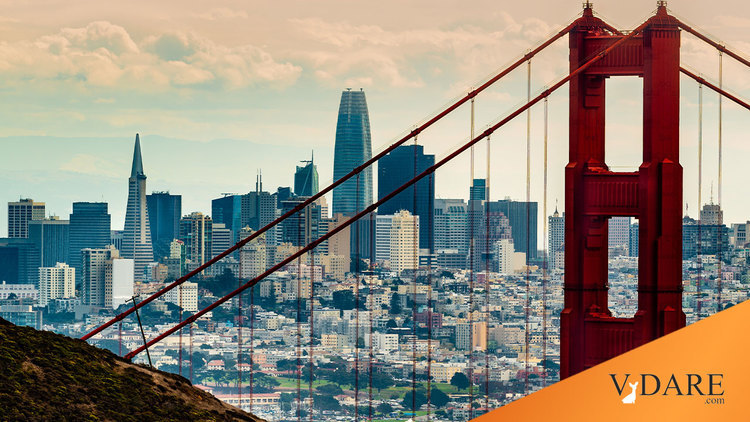Ryant Avent, an exponent of the Blade Runner school of urban planning, discussed in The Economist, discusses the "housing crisis in San Francisco," such as it is.
A new piece in TechCrunch makes this point nicely in a very good explainer of the housing crisis in San Francisco. The economy of the Bay Area is booming, but the region is one of the most difficult places to build in the country. Prices are therefore soaring and neighbourhoods are changing, touching off some occasionally nasty social conflicts.
But the author of the TechCrunch piece, Kim-Mai Cutler, puts her finger on the real problem. Yes, supply constraints are the cause of the affordability crisis. The trouble comes in trying to understand why those constraints are there and how to alleviate them.[The spectre haunting San Francisco ,Apr 16th 2014, ]
When I was a kid, San Francisco was the city of snobbism and environmental, historical, aesthetic, and who knows how many other constraints on building, while Los Angeles was just starting to move away from its pro-development, anti-elitist past. So, which ideology has worked out better?
San Francisco is down from 13.4% black in 1970 to 6.1% black in 2010, while Hispanics are only up from 11.6% to 15.1% over 40 years.
In contrast, Los Angeles, went from 18.3% Hispanic in 1970 to 48.2% Hispanic in 2010. Meanwhile, LA's black population declined from 10.8% to 9.3%, but that isn't a big change in absolute terms because the population of Los Angeles, unlike San Francisco, grew from 2.8 to 3.8 million in those 40 years. San Francisco grew from 0.7 to 0.8 million over 40 years.
So, super-liberal San Francisco has been impressively effective at driving out blacks and, perhaps more impressively, keeping out Mexicans. It's perhaps not a coincidence that the first Earth Day was in 1970, a couple of years after the Fair Housing Act was passed and exacerbated white flight from less desirable locations like the West Side of Chicago. Northern California was the center of the environmental movement, and has emerged, 45 years later, immensely wealthy.
Maybe the market will fix itself? That's not entirely impossible. Assume that there is persistence to zoning regimes, such that relatively liberal-building cities tend to stay that way even after population growth begins ramping up. And assume that as San Francisco deflects away would-be migrants to other cities, critical masses of people begin to pile up, leading to the growth of new tech hubs, at least some of which will occur in liberal-building places. Then maybe one eventually generates a flip in technological leadership to a city that likes building more than San Francisco.
Of course, the trend over the last 50 years has been in the opposite direction. Back in the Spirit of a New Machine era 35 years ago, Route 128 outside Boston was almost as fashionable as Silicon Valley. Not anymore. And Silicon Valley, which was always highly suburban, is increasingly following 1980s marketing yuppies like me and squeezing into the big city, as "tech" becomes increasingly less about making things and more about marketing.
So, yeah, eventually this trend will reverse itself, but you can go awfully broke waiting for that to happen.
On the other hand, if San Francisco zoning mostly deflects away non-techies who add to San Francisco congestion without adding much to its tech-centre synergies, then San Francisco's regulations may be reinforcing its status as technological leader.
Bingo. And if you can drive out non-techies who are, say, criminals, then life gets even better in San Francisco for those who can afford to live there.
That leaves technology as the saving grace.
Maybe we invent really good holodecks, which make it much less critical to actually be in San Francisco. Maybe we invent teleportation, laws of physics be damned. Maybe we simply come up with better ways to build and design cities, which minimise the real or perceived downsides to residents of new building.
Remember the Information Superhighway back in 1994? The idea was that you wouldn't have to jam into Silicon Valley suburbs, you could live in Santa Fe or Bozeman or wherever and do tech business without being there. How'd that work out anyway? Oh, the opposite happened, and now it turns out that not only do you have to squeeze into the greater San Francisco Bay area, you now have to squeeze into tiny San Francisco. Apparently, the technology of the Information Superhighway just couldn't be developed.
Or maybe we do nothing, and simply sit back and observe as housing remains an instrument of oligarchy. Who knows. But however one imagines this playing out, we should be clear about what is happening, and what its effects have been.
We should be clear, but not so clear as to mention minor matters like race, crime, and immigration policy.













